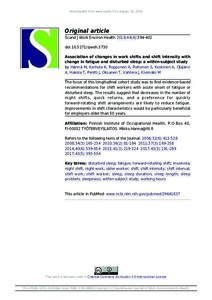Association of changes in work shifts and shift intensity with change in fatigue and disturbed sleep: a within-subject study
Harma M; Karhula K; Ropponen A; Puttonen S; Koskinen A; Ojajarvi A; Hakola T; Pentti J; Oksanen T; Vahtera J; Kivimaki M
Association of changes in work shifts and shift intensity with change in fatigue and disturbed sleep: a within-subject study
Harma M
Karhula K
Ropponen A
Puttonen S
Koskinen A
Ojajarvi A
Hakola T
Pentti J
Oksanen T
Vahtera J
Kivimaki M
SCANDINAVIAN JOURNAL WORK ENVIRONMENT & HEALTH
Julkaisun pysyvä osoite on:
https://urn.fi/URN:NBN:fi-fe2021042719503
https://urn.fi/URN:NBN:fi-fe2021042719503
Tiivistelmä
Objectives The aim of this study was to examine whether changes in work shifts and shift intensity are related to changes in difficulties to fall asleep, fatigue, and sleep length.Methods Questionnaire responses of hospital employees (N=7727, 93% women) in 2008, 2012, 2014 and 2015 were linked to daily-based records of working hours during three months preceding each survey. We used conditional logistic regression and longitudinal fixed-effects analyses to investigate odds ratios (OR) and 95% confidence intervals (CI) for each 25% within-individual change in the proportion of working hour characteristics in relation to changes in fatigue, difficulties to fall asleep, and 24-hour sleep length.Results Change in night but not in morning or evening shifts was associated with parallel changes in odds for longer sleep length (OR 1.45, 95% CI 1.28-1.64) and fatigue during free days (OR 1.38, 95% CI 1.16-1.64). Similarly, short shift intervals and having >2 but not >4 consecutive night shifts were associated with increased odds of fatigue during work and difficulties to fall asleep (OR 1.42, 95% CI 1.19-1.72 and OR 1.10, 95% CI 1.05-1.19, respectively). Among workers aged >= 50 years, the associations were the strongest between night shifts and longer sleep (OR 2.24,95% CI 1.52-3.81) and between higher proportion of short shift intervals and fatigue during free days (OR 1.68, 95% CI 1.10-2.54).Conclusions Among shift workers with fatigue or sleep problems, decreasing the proportion of night shifts and quick returns and giving preference to quickly forward-rotating shift systems may reduce fatigue.
Kokoelmat
- Rinnakkaistallenteet [27094]
